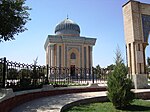Ibn Kemal
al-Mu'allim al-Awwal (The First Teacher)[1] Ibn Kemal | |
|---|---|
 16th-century miniature of Ibn Kemal | |
| Personal life | |
| Born | Şemseddin Ahmed 1468 |
| Died | 14 April 1534 (aged 65–66) |
| Era | 15th-century |
| Main interest(s) | Aqidah, Tafsir, Tasawwuf, Hadith, Fiqh, Usul, Ma'aani, Mantiq, Falsafa, Ottoman history |
| Notable work(s) | Tevarih-i Al-i Osman ("The Chronicles of the House of Osman") |
| Occupation | Islamic scholar, Historian |
| Religious life | |
| Religion | Islam |
| Denomination | Sunni |
| Jurisprudence | Hanafi |
| Creed | Maturidi[2] |
Şemseddin Ahmed (1469–1534), better known by his pen name Ibn Kemal (also Ibn Kemal Pasha) or Kemalpaşazâde ("son of Kemal Pasha"), was an Ottoman historian,[3] Shaykh al-Islām, jurist[3] and poet.[4]
He was born into a distinguished military family in Edirne[3] and as a young man he served in the army and later studied at various madrasas and became the Kadı of Edirne in 1515.[5] He had Iranian roots on his mother's side.[6] He became a highly respected scholar and was commissioned by the Ottoman ruler Bayezid II to write an Ottoman history (Tevārīh-i Āl-i Osmān, "The Chronicles of the House of Osman"). During the reign of Selim the Resolute, in 1516, he was appointed as military judge of Anatolia and accompanied the Ottoman army to Egypt. During the reign of Suleiman the Magnificent he was appointed as the Shaykh al-Islām, i.e. supreme head of the ulama, a post which he held until his death.
Kemalpaşazâde was a crucially important figure in the codification of the Hanafi school of thought in its Ottoman iteration.[7]
Works
[edit]He "authored around 200 works in Turkish, Persian, and Arabic. His works include commentaries on the Qur'an, treatises on hadith, Islamic law, philosophy and theology (kalam), logic, Sufism, ethics, history, several books on Arabic and Persian grammar, literature, and a small diwan of poetry."[8]
His most famous history work is the Tevārīh-i Āl-i Osmān "The Chronicles of the House of Osman", a history of the Ottoman Empire which provides the most original and important source material now extant on the reigns during which he himself lived.[5]
Although best known as a historian, Kemalpaşazâde was also a great scholar and a talented poet. He wrote numerous scholarly commentaries on the Quran, treatises on jurisprudence and Muslim theology and philosophy, and during his stay in Egypt he translated the works of the Egyptian historian ibn Taghribirdi from Arabic. He also wrote in Arabic, a philological work entitled Daqāʿiq al-Haqāʿiq "The Subtleties of Verities". His best poetical works include the Nigaristan "The Picture Gallery", written in Persian and modeled upon the Būstān and the Golestān of Saadi Shirazi; a poem, "Yusuf ü Züleyha", in rhymed couplets, retelling the story of Joseph and Potiphar's wife; and Divān "Collected Poems", consisting mainly of lyrics.[9]
In philosophy and theology, he was a Maturidi theologian-philosopher who followed some opinions of ibn Arabi and anticipated some theories of Mulla Sadra.[10] Kemalpaşazâde also wrote a famous history of the Hanafi school of fiqh entitled Risāla fī Ṭabaqāt al-Mujtahidīn "The Treatise regarding Biographies of Jurists".[11]
Notes
[edit]- ^ Atâullah, Nev‘îzâde. Hadâiku'l-hakāik fî tekmileti'ş-Şekāik. Abdülkadir Özcan. p. 185.
- ^ Ibn, Kemal (1304). Resail. İkdam Matbaası. pp. 231–233.
- ^ a b c Kemalpashazade, Franz Babinger, E. J. Brill's First Encyclopaedia of Islam, 1913–1936, Vol.4, ed. M. Th. Houtsma, (Brill, 1993), 851.
- ^ The Reigns of Bayezid II and Selim I 1481–1520, V.J. Parry, A History of the Ottoman Empire to 1730, ed. M.A. Cook, (Cambridge University Press, 1976), 78.
- ^ a b History of the Ottoman Empire and Modern Turkey, Stanford J. Shaw, page 145, 1976
- ^ Inan, Murat Umut (2019). "Imperial Ambitions, Mystical Aspirations: Persian Learning in the Ottoman World". In Green, Nile (ed.). The Persianate World: The Frontiers of a Eurasian Lingua Franca. University of California Press. p. 83.
A preeminent scholar and madrasa professor, Kemalpaşazade was born into a distinguished family with Iranian roots on his mother's side.
- ^ Burak, Guy. The Second Formation of Islamic Law: The Hanafi School in the Early Modern Ottoman Empire. Cambridge Studies in Islamic Civilization. Cambridge: Cambridge University Press, 2015. doi:10.1017/CBO9781316106341.
- ^ İbrahim Kalın, "Ibn Kemal (873–940 / 1468–1534)" in Oliver Leaman (ed.), "The Biographical Encyclopedia of Islamic Philosophy", Bloomsbury Publishing (2015), p. 198
- ^ Christine Woodhead, 'Kemalpaşazade', in Encyclopaedia of Islam, ed. by Kate Fleet and others, 3rd Edition (Leiden: Brill, 2007–); doi:10.1163/1573-3912_ei3_COM_35404
- ^ İbrahim Kalın, "Ibn Kemal (873–940 / 1468–1534)" in Oliver Leaman (ed.), "The Biographical Encyclopedia of Islamic Philosophy", Bloomsbury Publishing (2015), p. 199
- ^ Burak, The Second Formation of Islamic Law, 72.


 French
French Deutsch
Deutsch
